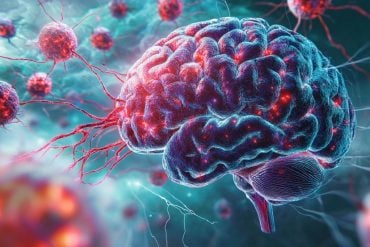Summary: Researchers have identified the structure of amyloid beta fibrils linked to a rare inherited form of Alzheimer’s disease caused by the Arctic mutation. Using cryo-electron microscopy and NMR, they revealed a W-shaped fibril structure that explains the formation of cottonwool plaques—large, spherical brain structures unique to this mutation.
These findings enhance our understanding of Alzheimer’s mechanisms and could guide the development of targeted therapies. This structural analysis offers hope for treating specific subtypes of Alzheimer’s and advancing antibody-based treatments.
Key Facts:
- The Arctic mutation creates W-shaped amyloid fibrils, forming cottonwool plaques.
- Cottonwool plaques are 10x larger than typical plaques seen in Alzheimer’s.
- Structural insights into amyloid fibrils may guide new antibody-based therapies.
Source: RIKEN
An international collaboration led by RIKEN researchers has discovered how unusual spherical structures form in the brains of people with a mutation that causes a form of inherited Alzheimer’s disease.
This discovery could help better understand the mechanics of the debilitating neurodegenerative disease.

Why Alzheimer’s disease strikes some people but not others is still largely mysterious. But in about one percent of cases that reason is clear—the person has inherited one of a handful of mutations that cause familial Alzheimer’s.
“The inherited form of Alzheimer’s disease can be caused by mutations to the gene that encodes for the amyloid precursor protein,” explains Yoshitaka Ishii of the RIKEN Center for Biosystems Dynamics Research.
Some of these mutations promote misfolding of the amyloid beta peptides into fibrillar aggregates, which are amyloid beta molecules clumped together in strings. Such amyloid beta fibrils are one of the hallmarks of all forms of Alzheimer’s disease, although their structures vary according to the disease variety.
Discovering the structures of amyloid fibrils of amyloid-beta peptides could shed light on how the disease develops. It could help with developing ways to prevent or treat the condition.
“Amyloid fibrils are key drug targets for antibody therapies for Alzheimer’s,” says Ishii. “It’s thus important to determine their structures.”
Now, Ishii and co-workers have prepared samples of amyloid beta fibrils produced by the Arctic mutation—so called because it was first found in Scandinavia. They then used cryo-electron microscopy and solid-state nuclear magnetic resonance (NMR) to determine its structure.
“While Alzheimer’s patients with the Arctic mutation exhibit similar symptoms as people with regular Alzheimer’s, the pathological features are unique,” says Ishii. “For example, a distinctive type of amyloid plaque called cottonwool plaque is often observed.”
Cottonwool plaques are large, spherical plaques. “In Alzheimer’s patients with the Arctic mutation, cottonwool plaques can be 200 micrometers in diameter, which is ten times larger than a typical plaque,” explains Ishii.
“But no one knew how these unique features were produced.”
Ishii’s team’s structural analysis has now revealed how cottonwool plaques may be formed by the mutation. “We’ve demonstrated that the unique W-shaped structure of amyloid fibrils produced by the Arctic mutation reproduces the major features of cottonwool plaques,” says Ishii.
Ishii and his team hope this kind of structural analysis will help Alzheimer’s research on two fronts.
“We believe that experimentally creating amyloid fibrils, which mimic the fibrils in various subtypes of Alzheimer’s disease, will reveal the complex mechanisms of Alzheimer’s,” says Ishii.
“This direction should also provide good potential targets for antibody or other therapies for the disorder.”
About this Alzheimer’s disease research news
Author: Yoshitaka Ishii
Source: RIKEN
Contact: Yoshitaka Ishii – RIKEN
Image: The image is credited to Neuroscience News
Original Research: Open access.
“E22G Aβ40 fibril structure and kinetics illuminate how Aβ40 rather than Aβ42 triggers familial Alzheimer’s” by Yoshitaka Ishii et al. Nature Communications
Abstract
E22G Aβ40 fibril structure and kinetics illuminate how Aβ40 rather than Aβ42 triggers familial Alzheimer’s
Arctic (E22G) mutation in amyloid-β (Aβ enhances Aβ40 fibril accumulation in Alzheimer’s disease (AD). Unlike sporadic AD, familial AD (FAD) patients with the mutation exhibit more Aβ40 in the plaque core. However, structural details of E22G Aβ40 fibrils remain elusive, hindering therapeutic progress.
Here, we determine a distinctive W-shaped parallel β-sheet structure through co-analysis by cryo-electron microscopy (cryoEM) and solid-state nuclear magnetic resonance (SSNMR) of in-vitro-prepared E22G Aβ40 fibrils.
The E22G Aβ40 fibrils displays typical amyloid features in cotton-wool plaques in the FAD, such as low thioflavin-T fluorescence and a less compact unbundled morphology.
Furthermore, kinetic and MD studies reveal previously unidentified in-vitro evidence that E22G Aβ40, rather than Aβ42, may trigger Aβ misfolding in the FAD, and prompt subsequent misfolding of wild-type (WT) Aβ40/Aβ42 via cross-seeding.
The results provide insight into how the Arctic mutation promotes AD via Aβ40 accumulation and cross-propagation.






